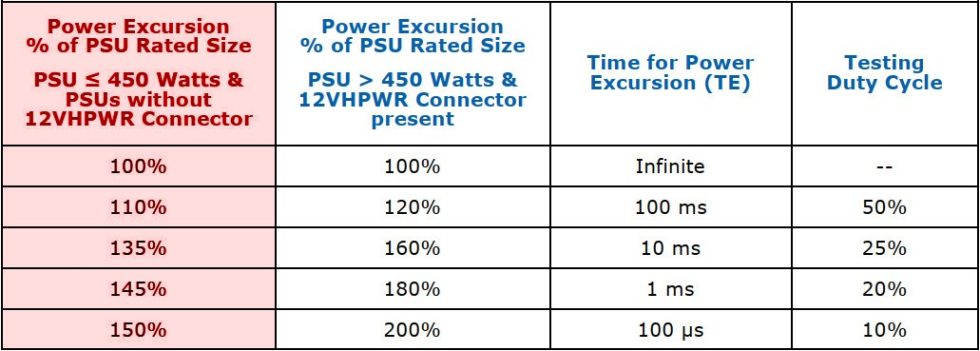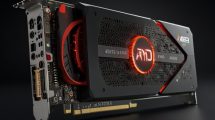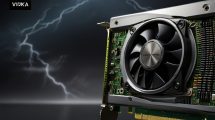ATX 3.0 with backdoor?
Intel’s new ATX 3.0 specification also doesn’t quite clearly state whether or not the new 12VHPWR connector is even necessary for power supplies with more than 450 W of power. This 450 watt limit actually results from the fact that a “new type” graphics card with over 300 watts TBP does not need power in the system alone. Therefore, ATX 3.0 also considers the “system performance” in the entirety of all consumers. What is always in focus there, of course, is the requirement to create the 200% load for the 100-ms load cycles in the hard tests for the transient response, which doubles the system load for this period.
Until now, everyone was actually of the opinion that the new ATX 3.0 specifications also require a 12VHPWR connection for any power supply with more than 450 W power, so that it is also PCIe 5.0 capable. Only if you look at the definition gaps of the PCIe 5.0 specification, then the whole thing is suddenly no longer quite so clear. This is where my friend Aris (hwbusters.com) and Jon Gerow (Jonnyguru) come in. Because they also discussed whether a new ATX 3.0 power supply must have the new PCIe connector explicitly or not. Jon showed Aris the following table from the ATX specification and said that the first column (which I’ve highlighted in red) was really something:
In fact, it states that power supplies with a maximum power of 450 W or less AND power supplies without 12VHPWR connections don’t even have to go up to 200% in the transient response tests, but only up to 150%. So why does Intel also include power supplies without a 12VHPWR connector, which can be assumed to also have more than 450 W maximum power? Is this also an indication that a power supply can still be ATX 3.0 compatible without a 12VHPWR connector, even if it offers more than 450 W of power? This would then, I conclude, also follow the gaps in the PCIe 5.0 specification. However, Aris then referred to a chapter heading from the ATX 3.0 specification that actually clearly shows a limitation:
And now? Intel clearly states in this heading that ANY power supply with more than 450 W power must have a 12VHPWR connector! Intel also lists power supplies without a 12VHPWR connector in the first column of Table 3-3, regardless of power, and at the same time, paragraph 5.2.2.4.3 clearly states that all power supplies over 450 W must have the new PCIe connector. Contradiction of the first order and time to ask Intel!
With this problem, Jon (who, by the way, is responsible for Corsair’s power supply development) turned to Intel for more information. The answer is perplexing because, in fact, a power supply can offer more than 450 W of power and still NOT have a 12VHPWR connector! Why this is important now, we can see from the table above! Because exactly these power supplies without 12VHPWR do not have to pass the particularly hard transient tests with up to 200% load! The tests for the transient response of power supplies without the new PCIe connector namely “only” go up to 150%! Conversely, of course, this means less hassle for power supply manufacturers, as they won’t even have to redesign their platforms much to offer ATX 3.0 compatibility!
Interim conclusion: What about PCIe 5.0 now?
Thus, according to Jon’s findings, power supplies don’t have to have a 12VHPWR connector at all to be fully ATX 3.0 capable in principle, and they also have to pass less stringent tests. On the other hand, it is odd that now a manufacturer or brand can release a new power supply with performance high enough to run at least a new mid-range graphics card and then not equip it with a PCIe 5.0 connector that would future-proof it. For customers this will only confuse them senselessly.
Of course, it would be absurd to offer new ATX 3.0 power supplies with more than 450 watts without the 12VHPWR and not natively support the upcoming graphics cards. But I already wrote on page 1 that adapters are also planned that can then be used. Cheapies will naturally look for the courage to cut corners here, though informed users will naturally prefer power supplies with PCIe 5.0 ports to those that don’t.
Also, power supplies with PCIe 5.0 connectors have a higher tolerance to load spikes, so most users will probably feel much safer with them as well! Always assuming users have also read articles like mine on the subject of these load spikes. The fact that the ATX 3.0 specification also allows power supplies with more than 450 W that don’t have 12VHPWR connectors doesn’t change the fact that you should probably also use a new, PCIe 5.0-capable power supply for most new GPUs if you still own an ancient power supply.




































43 Antworten
Kommentar
Lade neue Kommentare
Mitglied
Urgestein
Neuling
Veteran
Veteran
Urgestein
Urgestein
Veteran
Mitglied
Veteran
Mitglied
Mitglied
Mitglied
Urgestein
1
Urgestein
Mitglied
Veteran
Mitglied
Alle Kommentare lesen unter igor´sLAB Community →